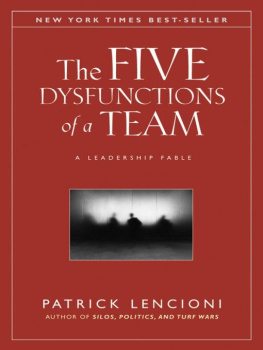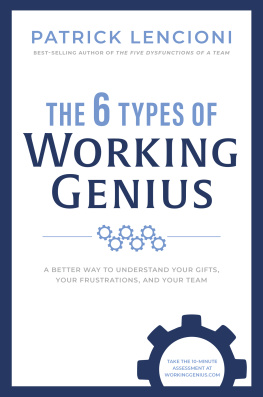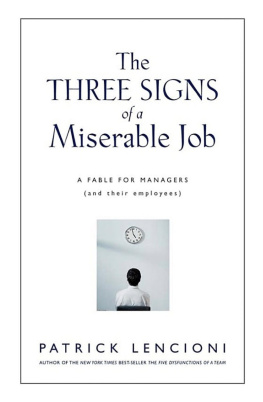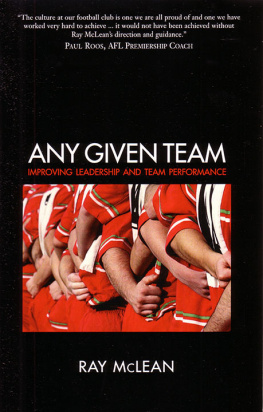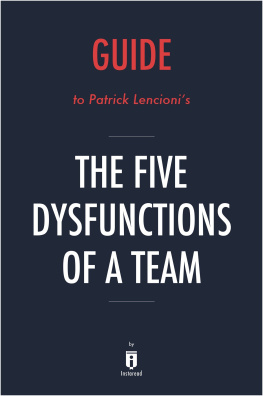Table of Contents
Published by
Copyright 2002 by Patrick Lencioni.
Jossey-Bass is a registered trademark of John Wiley & Sons, Inc.
No part of this publication may be reproduced, stored in a retrieval system, or transmitted in any form or by any means, electronic, mechanical, photocopying, recording, scanning, or otherwise, except as permitted under Sections 107 or 108 of the 1976 United States Copyright Act, without either the prior written permission of the Publisher or authorization through payment of the appropriate per-copy fee to the Copyright Clearance Center, 222 Rosewood Drive, Danvers, MA 01923, (978) 750-8400, fax (978) 750-4744. Requests to the Publisher for permission should be addressed to the Permissions Department, John Wiley & Sons, Inc., 605 Third Avenue, New York, NY 10158-0012,
(212) 850-6011, fax (212) 850-6008, e-mail: permreq@wiley.com.
Jossey-Bass books and products are available through most bookstores. To contact Jossey-Bass directly, call (888) 378-2537, fax to (800) 605- 2665, or visit our website at www.josseybass.com. Substantial discounts on bulk quantities of Jossey-Bass books are available to corporations, professional associations, and other organizations. For details and discount information, contact the special sales department at Jossey-Bass.
We at Jossey-Bass strive to use the most environmentally sensitive paper stocks available to us. Our publications are printed on acid-free recycled stock whenever possible, and our paper always meets or exceeds minimum GPO and EPA requirements.
Library of Congress Cataloging-in-Publication Data
Lencioni, Patrick, 1965-The five dysfunctions of a team: a leadership fable / Patrick Lencioni. p. cm.
ISBN 0-7879-6075-6
1. Teams in the workplace. I. Title.
HD66 .L.4036-dc21 2001008099
HB Printing
To Dad, for teaching me the value of work. And to Mom, for encouraging me to write.
INTRODUCTION
Not finance. Not strategy. Not technology. It is teamwork that remains the ultimate competitive advantage, both because it is so powerful and so rare.
A friend of mine, the founder of a company that grew to a billion dollars in annual revenue, best expressed the power of teamwork when he once told me, If you could get all the people in an organization rowing in the same direction, you could dominate any industry, in any market, against any competition, at any time.
Whenever I repeat that adage to a group of leaders, they immediately nod their heads, but in a desperate sort of way. They seem to grasp the truth of it while simultaneously surrendering to the impossibility of actually making it happen.
And that is where the rarity of teamwork comes into play. For all the attention that it has received over the years from scholars, coaches, teachers, and the media, teamwork is as elusive as it has ever been within most organizations. The fact remains that teams, because they are made up of imperfect human beings, are inherently dysfunctional.
But that is not to say that teamwork is doomed. Far from it. In fact, building a strong team is both possible and remarkably simple. But it is painfully difficult.
Thats right. Like so many other aspects of life, teamwork comes down to mastering a set of behaviors that are at once theoretically uncomplicated, but extremely difficult to put into practice day after day. Success comes only for those groups that overcome the all-too-human behavioral tendencies that corrupt teams and breed dysfunctional politics within them.
As it turns out, these principles apply to more than just teamwork. In fact, I stumbled upon them somewhat by accident in my pursuit of a theory about leadership.
A few years ago I wrote my first book, The Five Temptations of a CEO, about the behavioral pitfalls that plague leaders. In the course of working with my clients, I began to notice that some of them were misusing my theories in an effort to assess and improve the performance of their leadership teams and with success!
And so it became apparent to me that the five temptations applied not only to individual leaders but, with a few modifications, to groups as well. And not just within corporations. Clergy, coaches, teachers, and others found that these principles applied in their worlds as much as they did in the executive suite of a multinational company. And that is how this book came to be.
Like my other books, The Five Dysfunctions of a Team begins with a story written in the context of a realistic but fictional organization. I have found that this allows readers to learn more effectively by losing themselves in a story and by being able to relate to the characters. It also helps them understand how these principles can be applied in a nontheoretical, real-world environment, where the pace of work and the volume of daily distractions make even the simplest of tasks seem arduous.
In order to help you apply the material in your own organization, a brief section following the story outlines the five dysfunctions in detail. That section also includes a team assessment and suggested tools for overcoming the issues that might be plaguing your team.
Finally, although this book is based on my work with CEOs and their executive teams, its theories are applicable for anyone interested in teamwork, whether you lead a small department within a company or are simply a member of a team that could use some improvement. Whatever the case may be, I sincerely hope it helps your team overcome its particular dysfunctions so that it can achieve more than individuals could ever imagine doing alone. That, after all, is the real power of teamwork.
The Fable
LUCK
Only one person thought Kathryn was the right choice to become CEO of DecisionTech, Inc. Luckily for her, that person was the Chairman of the board.
And so, less than a month after the previous chief executive had been removed, Kathryn Petersen took the reins of a company that just two years earlier had been one of the most talked-about, well-funded, and promising start-up companies in the recent history of the Silicon Valley. She could not have known just how far from grace the company had fallen in such a short period of time, and what the next few months had in store for her.
PART ONE
Under-achievement
BACKSTORY
DecisionTech was located in Half Moon Bay, a foggy, coastal farming town just over the hills from the San Francisco Bay. It was not technically part of the Silicon Valley, but the Valley is not so much a geographical entity as a cultural one. And DecisionTech certainly fit within that world.
It had the most experiencedand expensiveexecutive team imaginable, a seemingly indestructible business plan, and more top-tier investors than any young company could hope for. Even the most cautious venture firms were lining up to invest, and talented engineers were submitting their resumes before the company had leased an office.
But that was almost two years earlier, which is a lifetime for a technology start-up. After its first few euphoric months of existence, the company began experiencing a series of ongoing disappointments. Critical deadlines started to slip. A few key employees below the executive level unexpectedly left the company. Morale deteriorated gradually. All of this in spite of the considerable advantages that DecisionTech had amassed for itself.

